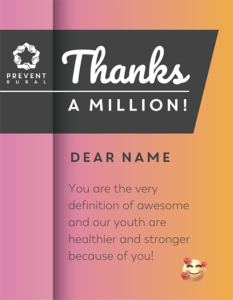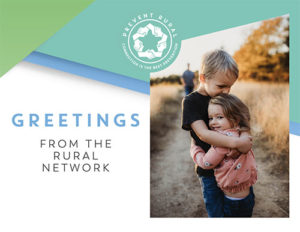The Statewide Rural Network
“A gathering of rural people who support youth in their journey to whole health.” Rural ConferenceRural ToolkitRural Photo Library
We’ve put together a collection of free stock and user submitted photos available to use in campaigns and materials.
Rural Photo Tips
If you don’t find what you’re looking for above, here are some additional tips in the types of photos we’re looking for:
Types of Photos We're Looking For:
- Photos of teens in realistic rural situations
- People in a meeting together
- People at a coalition meeting working on projects in small groups
- Large group discussions or presentations
- High School football game in small town
- Kids playing outside
- Normalized non-affluent housing backgrounds
- Taking care of animals
- Graduation events
- Families – kids playing with teenagers
- Rural Latinx youth
- Mentor-Mentee activities
- Award ceremonies
- Rural native communities
- Rural schools, teachers in rural buildings
- Youth engaging in multi-generational activities especially with younger, youth/senior citizens; dancing, gardening, outdoor music events, picnics
- Sports
- Parades
- Family gatherings
- Rural town halls
- Youth conservation core outreach
- Outdoors teamwork
- People in Eastern Washington landscapes like desert, scrub, farmlands, oak groves, etc.
- Healthy activities in various settings that you might find among our network
- Youth on their phones in rural settings
- Kids of all ages
- Nothing too clean or polished
- Pictures of community events
- WA Prevention Summit youth connecting with other youth
- Kids on 4Wheelers getting the mail on long driveways
- Rural activities
- Driving a beat up truck
- Laughing around a bonfire
- Small town high school football game
- County fairs
- Festivals
- Hunting
- Kids working on school projects together
- Fishing
- Rural neighborhoods
- Small main town areas
- Places where people gather in rural areas
- Wheat harvest
- Youth led activities at county fairs
- Diverse cultural representation
- Fields, lakes, forests
- Older people with younger people talking as equals
- Kids that are in rural backgrounds that are still dressed “alternative” in black, rainbows and maybe challenges gender norms
- Show pictures that represent the intelligence and wisdom of rural people
- Agriculture machinery
- Highlight the positive parts of rural life
- Students on a zoom or conference call
- Youth working on homework with their parents or older siblings
- Wearing Carhartt, mullets, boots, muck boots
- Saw mills and other industrial buildings
- Log trucks, things that are blue collar
- (Refer to Down and Dirty campaign from Virginia)
- Cows at a wash rack
- Cook offs, festivals, county fairs, blue ribbons
- Ropers, Romeo shoes
- Old trucks – Subaru. “Not fast but it’s loud.” Trucks with hay bails
- Harvest pantries with farms
- Haunted school busses
Types of Photos to Avoid:
- Cliché “plaid shirts and hay bales” photos
- Skip the “Old MacDonald had a farm” look
- Kids that all look the same. Rural kids blend social groups
- Urban or suburban scenes
- Anything “too fancy”
- Overly stages photos
- City busses
- Airpods
- Teens looking at their phones on concrete steps
- Nothing too polished i.e. overly edited and photoshopped landscapes
- Homogeneous people, unless that’s truly the community
- Stereotypes, like a plaid shirt and suspenders and cowboy hats. Rural teens are still into the trends as much as anywhere. However, there is a place for the cowboy look at times
- Big cities, skyscrapers, subways, large airports, big freeways,
- Areas with asphalt, and cement
- Photos that underrepresent economically challenged rural communities
- Avoid too many landscape photos, go for neighborhoods instead
- We want to avoid pictures that are alienating or that make rural people look stereotypically uneducated
Rural Coalition Canva Templates
Why Canva?
Canva.com is a free service that allows you to modify, adjust, and adapt these templates to your local needs. You can delete our logo or pictures and add your own! We chose Canva because it does not require a subscription in order to make these local adaptions. The alternative would be to create a PDF resource that members could adjust using Adobe Pro, however Adobe products tend to be expensive and require more skill to use.
To get started:
- Click our Thank You Card or Post Card button
- At the bottom of the design page click the purple ”Use Template” button
- You will be prompted to sign up. You may use your Google login, Facebook login, or can enter an email
- Continue with account creation and you will find yourself back at the template page for editing.
- To learn more about creating with this tool, visit https://designschool.canva.com/tutorials/.
Thank you cards

Post cards

Healthy Youth Survey Social Media Toolkit
The Healthy Youth Survey (HYS) collects important data that helps schools, communities, and policymakers support youth. Your school’s participation is vital because it helps us understand youth experiences.
The HYS is planned for Fall 2025 and future odd numbered years. The Prevent Rural Network Affinity Group developed a social media toolkit to share with your communities to encourage HYS participation and to stress the importance of participating in the survey.
The social media toolkit includes graphics and sample messages that can inform school administrators, teachers, families, and youth. These were created with a specific focus on rural communities and their needs; however, they can be shared widely with whomever you feel is appropriate or may need the information.
Greater youth participation in the HYS provides more solid data about youth behaviors which helps our future prevention efforts! Feel free to reach out to preventcoaltion@esd112.org if you have any questions.
Email & Letter Templates
Audience-specific email and letter templates for recruiting coalition members are available for to download and edit, as needed.
Email Templates
Letter Templates
Rural Coalition Success Stories
These stories have been submitted by rural coalitions across the state of Washington. Click on a topic to sort the stories.
One coalition distributed flyers at the local garbage dump because is is one spot where everyone in town visits.
One coalition uses fortune cookies to network and advertise their meetings.
I had to go slow and steady to change our meeting time and date for the coalition, because we were sharing a meeting with another group. I had to go through two leadership teams before we could make this change. I couldn’t push it myself as the coordinator. I had to respect the views of my leadership team and coalition members at the time. When we changed leadership, I brought it up again, and they went for it. We risked losing members and losing sectors, but I was willing to make the risk in order to have our own separate meeting that was action-oriented, and not so focused on just reporting out.
-Sarah at Pomeroy Partners in Garfield County, WA
Instead of starting out with trying to tackle a community-wide indoor vaping ordinance, we are starting with asking the County Commissioners to create a ruling for just county buildings, and we will build from that.
-Sarah at Pomeroy Partners in Garfield County, WA
Sometimes local officials don’t know certain problems exist until it’s pointed out to them. In 2018, our youth prevention club created a “Photo Voice” exhibit. The project asked students to go around the community and take pictures of things that give them joy. Students took pictures of local fishing spots, hiking trails, pets, mountains and the river. We then asked them to take pictures of things they don’t like seeing in their community. Students took pictures of litter, cigarette butts, beer cans, graffiti and a burned-out old train car. Several students took pictures of this and it was included in the exhibit. Our town Mayor attend the event and was so moved by the video, four months later started the process of removing the old train car from the town.
-Stephanie from Concrete Resource Coalition in East Skagit County, WA
One person in a small town was the only one supporting local policy to build windmills. Most everyone was against them but one by one they met with key influencers in the community (people they know had sway and influence). Over time, they were able to use these connections to change public opinion and the windmills got built creating new jobs, revenue and sustainable energy.
-Garfield County
We tried for years to run parenting classes, but our efforts were not effective. The amount of money we spent on advertising and the staff time needed for each class that resulted in having nobody show up was not worth it. Instead, to educate parents, we ramped up our adult media campaign. We inserted short lessons from the parenting class into our Key Leader Event, 7th grade orientation, Parent-Teacher Conferences, and in-service trainings at the school. We weren’t running the class at all, but we were able to get a tiny bit of the information to parents.
-Sarah at Pomeroy Partners in Garfield County, WA
Our local YMPEP network and CPWI coalition have been working closely together and partnering on projects throughout the past year. They’ve been connecting with city leaders to develop new vape policies for city offices, and parks, and have been supporting the state wide Prevention Voices group who is attempting to ensure that some the temporary alcohol and marijuana allowances do not become permanent. The Shelton and North Mason Substance Abuse Prevention Coalition members also assisted their Coordinator with the 2020 Retail Marijuana Survey. They have been vital in ensuring that our community outreach projects continue to occur, including planning and developing World Opiate Awareness day events and hanging up balloons in Belfair in support of Red Ribbon Week on a rainy fall day.
-Ben from Shelton and North Mason Counties in Belfair, WA
We had low attendance for our Key Leader events. When we started combining our Key Leader events with our annual Award Night for our local youth in May, we had better success.
-Stephanie from Concrete Resource Coalition in East Skagit County, WA
One coalition in Southwest Washington was promoting a “National Drug Take Back Day” event only to realize that the community was already using the year-round medication drop box. They were experiencing low turn-out at the take back days. They instead promoted year-round locations and had greater success.
Before COVID, we distributed “Nature Remedies” calendars made by the coalition at the Mason County Oysterfest. Over 10,000 people attend the two-day seafood event. We distributed the calendar for free and explained who we are and what our coalition does. During COVID, we had to be creative and provided 2,500 calendars to a senior newsletter that was delivered throughout the county.
-Ben from Shelton and North Mason Counties in Belfair, WA
Fit programs into an existing group. For example, offering the evidence-based program SPORT during an already existing Summer Youth Program. Technically it’s not an adaptation but it is an opportunity! We also partnered with a small youth program that had one part-time staff to create a subcontract and start a mentoring program. We really had to look outside the box on ways to partner with them, and the mentoring program ended up working out.
-Sarah at Pomeroy Partners in Garfield County, WA
Our North Mason Youth Prevention Club has participated in a program called “Safety Days” for the past few years. The event is Sponsored by the North Mason Fire Department. Students grade K-5 spend a full day going from one safety booth to another learning about fire and household safety. Each booth has a safety message to share with the students. The Prevention Club presents on syringe and drug safety, “Stay away and tell an adult!” Last June, they partnered with the Fire Department to write different prevention messages. The Prevention Club planned and developed a virtual safety day video. The video was later distributed to the students by teachers in all classes.
-Ben from Shelton and North Mason Counties in Belfair, WA
In March 2021, I began hosting monthly, 1-hour, mid-day “mini dives into prevention topics” and inviting members of our local coalition and other community members from my own and neighboring communities who may not yet be formally involved in strategic prevention planning/implementation. The topics vary widely, but the through-line is that each presentation underlines how the featured topic fits within the prevention web. These presentations are a casual way to draw people into our coalition’s work, or the prevention work going on in their community, without asking for much commitment. It’s also a fantastic way to build relationships with other organizations and increase connection between partners, because I can ask different folks to help me present on a topic. For example, Christopher Belisle of Prevent Coalition helped me present in March on “Intro to Prevention Policy Advocacy” and Jesse Jimenez, also of Prevent Coalition, helped me in April to present on the Rural Network’s Rural Healthy Youth Survey Report.
-Trillium from Coalition for Orcas Youth in Island County, WA
Instead of looking for new coalition members to attend meetings, I instead looked for coalition partnerships. For example, the local Booster Club – how we help them FIRST before inviting them to a meeting? I also joined the Chamber of Commerce before asking them to attend our meetings. Building relationships BEFORE I make the ask. Thinking way outside of the box, but still within the parameters of the grant. Putting their needs first has been a great way to build partnerships and then they join the coalition out of their own interest.
-Sarah at Pomeroy Partners in Garfield County, WA
Subcontracting our funds out to the local health department and other nonprofits has done wonders! Subcontract as much as you can, and thank your Subcontractors well. If you can’t hire more staff, then subcontract.
-Sarah at Pomeroy Partners in Garfield County, WA
Put fliers all over town. Fliers at the coffee shop counter. We do Every Door Direct Mail through USPS because our town is so small, it is not very expensive to mail every household a postcard advertising an event. Facebook ads are also very inexpensive because of the local targeting.
-Sarah at Pomeroy Partners in Garfield County, WA
Pop Sockets for cell phones were a huge hit at our local high school. Each one had the hashtag for our new social norms campaign.
-Stephanie from Concrete Resource Coalition in East Skagit County, WA
Go to your audience. We have a popular Bingo event every Fall. I made a prevention Bingo card (made on a www.bingobaker.com) and handed one to every person for free. I added names of our programs, events and our coalition. When I called out a word for the Bingo card, I included two sentences about that event, the coalition or program. The winner received a donated $25 gift card to our local grocery store and I was able to give a small introduction of our resources to 40 families in our rural community.
-Stephanie from Concrete Resource Coalition in East Skagit County, WA
We have created and distributed 5000 calendars for the past two years called “Nature Remedies.” The calendar is focused on things that residents can do here in our own community that revolve around using nature as a “remedy”. Each month you’re asked to read a list of things to see or do! Things like seeing where the sun comes up, noticing things or exploring in ways that you will need to find out for yourself, or paying special attention to friends and family during times of transition (moving, loss, new job). We also added prevention messaging such as prescription drug disposal tips and web sites. It includes 12 months, each connected to or associated with the four seasons.
-Ben from Shelton and North Mason Counties in Belfair, WA
Sponsored by the Washington State Department of Health Dedicated Marijuana Account.
Not finding what you’re looking for?
Send us a message with what you’re trying to find, or your ideas for adding to the toolkit.
For more information, contact preventcoalition@esd112.org.
